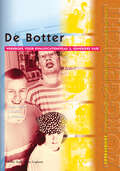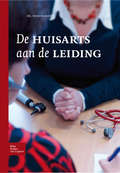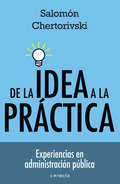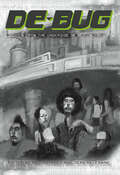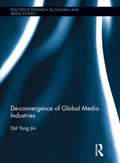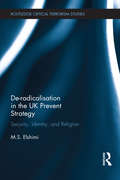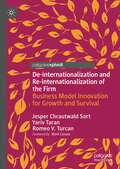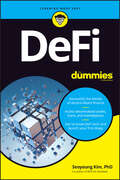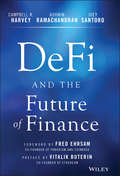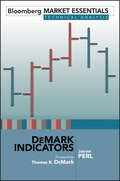- Table View
- List View
De botter
by Nicolien Van Halem S. Borkus Mevrouw L. PetersenZorgcategorie: Verstandelijk gehandicapten Setting: Leefgroep Korte inhoud: De leefgroep De Botter staat in de instelling bekend als een 'dynamische' groep. De groepsleden zijn jong volwassenen en het ontwikkelingsniveau varieert van midden tot hoog niveau. Het is een gemengde groep en bestaat, na de verhuizing van Rebecca, uit één meisje en vijf jongens. Naast epilepsie doen zich communicatie en gedragsproblemen voor, waardoor het accent in de zorg komt te liggen op intensieve begeleiding.
De burger de baas
by Eeke van der Veen Willem WansinkDe democratie staat onder druk, de zorg ook. Het wantrouwen van burgers in de overheid en maatschappelijke instituties neemt toe. Mensen voelen zich buitenspel staan, elke misstand in een ziekenhuis of verpleeghuis wordt uitvergroot. Betrokkenheid is de basis van de samenleving. Valt die basis weg, dan dreigt het recht van de sterkste de overhand te krijgen. ‘De burger de baas’ is een aanmoediging om dat te voorkomen. Dit boek wil de burger zijn zorg teruggeven. Het is een pleidooi voor betrokkenheid en creatieve veranderingen van binnenuit. Daarvoor is kennis nodig. Kennis van het reilen en zeilen van de gezondheidszorg. Kennis van de keuzes die worden gemaakt. Nu kiezen en beslissen anderen te vaak voor u. ‘De burger de baas’ is vanuit persoonlijk engagement en jarenlange ervaring geschreven door twee kenners van de zorg: oud-politicus Eeke van der Veen en publicist Willem Wansink.
De compras con él y ella
by Elizabeth PaceVenda más y mejor conociendo a su cliente.La ciencia es muy clara: los hombres y las mujeres usandiferentes partes de su cerebro y por lo tanto se comportan de manera distintaen muchísimas situaciones, incluyendo la manera en que vamos de compras,compramos y consumimos productos y servicios. Como profesional de ventas,publicidad o mercadeo, entender estas diferencias es la clave de nuestro éxito. Paraaumentar las ventas, usted debe comprender lo que de manera singular impulsa asus clientes, masculinos o femeninos, y maximizar sus opciones para comunicarsecon ellos. Ya sea que venda productos tangibles como autos y casas o productosintangibles como servicios financieros o soluciones de negocios, De compras con él y ella le ayudará aentender las inherentes percepciones, motivaciones y emociones específicas delos cromosomas X e Y. Estas perspectivas son la manera más poderosa paraaumentar los ingresos.
De familie Yilmaz
by S. Schippers N. Van Halem Arno Goedhart G.W. de Nooijer-JanseZorggericht De familie Yilmaz.
De heer Belfort
by A. Haagsma J. Sevenhuijsen J.H. van MeterenZorgcategorie: Geriatrische zorgvragerSetting: Het geriatrisch netwerkKorte inhoud: Deze casus gaat over meneer Belfort en zijn dementie. De verschillende fasen van dementie, de achtergrond en rol van de familie en omgeving komen aan bod, evenals het geriatrisch netwerk van de huisarts, thuiszorg, het algemeen ziekenhuis, de GAAZ, het verpleeghuis en de alternatieve woongroepvormen.
De heer Goossens
by W.C. van Roekel M.H.J. van den Borne M.C.C. HoltmanZorgcategorie: Zorgvrager met darmtumor Setting: Algemeen ziekenhuis, afdeling chirurgie Korte inhoud: Meneer Goossens is de hoofdpersoon uit de casus van dit boek. Daarnaast maak je kennis met meneer Visser. Bij meneer Goossens is kortgeleden darmkanker vastgesteld en hij komt in het ziekenhuis om deze kanker te laten verwijderen. Meneer Visser heeft enige jaren geleden strottenhoofdkanker gehad en heeft inmiddels zijn leven weer opgebouwd. Beide heren hebben een stoma, meneer Goossens krijgt een darmstoma, meneer Visser heeft een tracheostoma.
De heer Kamminga: Werkboek voor kwalificatieniveau 3, deelkwalificatie 309 (Zorggericht)
by M. Cingel N. Halem J.G.M. HuttenZorgcategorie: Geriatrische zorgvrager Setting: VerzorgingshuisKorte inhoud: Steeds meer mensen bereiken een hoge leeftijd in onze maatschappij. De 'vergrijzing' neemt toe. Dit gegeven kom je veelvuldig tegen in de statistieken van kranten en andere media. De ouderdom kan wijsheid, inzicht en bezinning opleveren, maar ook verdriet door verlies van geliefden en bekenden en eenzaamheid. Daarnaast krijgt het afnemen van psychische en lichaamsfuncties een belangrijke plaats. Je maakt kennis met een aantal ziekten die kunnen horen bij de laatste levensfase en met een aantal voorkomende gedragsproblemen. Je ontwikkelt kennis, houding en vaardigheden om je voor te bereiden op de zorg voor deze bewoners.
De huisarts aan de leiding: De huisarts aan de leiding
by Erik RanzijnHuisartsen zijn niet alleen verantwoordelijk voor de zorg voor hun patiënten, maar ook voor de zorg voor hun personeel. Het doel van de huisarts is te zorgen dat medewerkers in de praktijk hun werk beter gaan doen en met meer plezier. Daarvoor is het belangrijk om gestructureerd leiding aan de praktijk te geven. Het boek De huisarts aan de leiding biedt huisartsen praktische handvatten om effectief leiding te geven. In hoofdstuk 1 worden de belangrijkste theorieën over leidinggeven op een rijtje gezet en verschillende leiderschapsstijlen en rollen behandeld. In hoofdstuk 2 staat leidinggeven in de praktijk centraal. De auteur bespreekt verschillende communicatievormen en gespreksvaardigheden en behandelt aan de hand van stappenplannen en praktijkvoorbeelden hoe je als huisarts effectief leiding kunt geven: hoe geef je heldere instructies? Hoe motiveer je je personeel? Hoe los je problemen op? Hoe ga je om met onverwachte situaties? Hoe pak je beoordelingsgesprekken aan? De auteur wijst daarbij ook op de belangrijkste valkuilen.
De la idea a la práctica: Experiencias en administración pública
by Salomón ChertorivskiUn libro sobre administración pública, serio y riguroso pero de fácil lectura, expone las más importantes teorías sobre liderazgo aterrizadas en la realidad nacional y sobre la base de una serie de experiencias recientes que el autor puso en práctica con óptimos resultados. Cómo establecer una agenda, construir una estrategia y definir los valores y objetivos que han de guiar a una organización gubernamental. Cómo buscar las oportunidades para innovar y que los proyectos perduren más allá de la gestión sexenal. De la idea a la práctica es un libro preciso y de fácil lectura acerca de un tema que pocas veces ha sido tratado en la literatura de management: el liderazgo en la administración pública. Salomón Chertorivski, un especialista en la materia, expone las más importantes teorías sobre liderazgo aterrizadas en la realidad nacional a partir de una serie de experiencias donde ha puesto en práctica los conocimientos que ahora comparte. En estas páginas el autor ofrece un nuevo modelo de gestión administrativa que tiene como uno de sus objetivos principales la instrumentación de procesos de innovación óptimos y efectivos dentro del aparato institucional. Para ello el funcionario público debe aprender a construir liderazgos, desarrollar habilidades y actitudes que lo transformen en un agente de cambio exitoso y, por supuesto, estar convencido de la esencia de su vocación: la búsqueda del bien común. En suma, el propósito de esta obra es proporcionar las herramientas para que el servidor público de cualquier nivel pueda desplegarse como líder de un equipo de trabajo y conseguir las metas planteadas. El libro de Salomón Chertorivski se coloca a la vanguardia y está llamado a ser una referencia obligada para profesionales de la administración, maestros, estudiantes y ciudadanos preocupados por el buen funcionamiento de nuestros gobiernos.
De la indignación a la esperanza: Construir la España del bienestar es posible
by José Carlos Díez<P>Cinco años después de la publicación de Hay vida después de la crisis, José Carlos Díez regresa al análisis de la actualidad económica con un libro escrito desde la convicción de que hay motivos para la esperanza y propone un plan para conseguir una España, una Europa y un mundo mejor para los ciudadanos. <P>¿Es verdad que ha terminado la crisis? ¿Qué secuelas ha dejado en el país? ¿Inflaremos otra burbuja como la del ladrillo? ¿Está España condenada a vivir del turismo? ¿Qué consecuencias tendrá el Brexit para los ciudadanos europeos? ¿Qué efectos está provocando la presidencia de Donald Trump en el orden económico mundial? ¿Qué camino le queda al estado del bienestar? <P>En junio de 2012 España fue rescatada por nuestros socios europeos y el Fondo Monetario Internacional. Nos encontrábamos en uno de los momentos económicos más convulsos de los últimos cuarenta años y la situación fue adquiriendo tintes sombríos en los meses posteriores, en los que alcanzamos la cifra de 6 millones de desempleados y un 27% de tasa de paro. <P>Alarmado por la gravedad de la situación, en mayo de 2013 publiqué mi primer libro, Hay vida después de la crisis, con el propósito de contribuir al debate y explicar las causas de esta maldita crisis que tan grandes cicatrices ha dejado: ha elevado el paro de larga duración hasta el punto que, en muchos casos, se ha convertido en pobreza; ofrece trabajos precarios y escasos a nuestros jóvenes mientras la cesta de la compra y las facturas de bienes básicos, como la electricidad, se han disparado. <P>Vivimos un momento crítico en el que, de nuevo, veo con preocupación el futuro y discrepo del mensaje oficialista. Por esta razón, me parece necesario regresar a las propuestas que nos lleven a recuperar la dignidad de este país y de sus ciudadanos. <P>No resulta sencillo sostener que hay vida después de la crisis, pero estoy seguro de que construir la España del bienestar es posible. Recorramos juntos el camino de la indignación a la esperanza.
De la mano de la confianza: Historias que vale la pena conocer para poder repetir
by Juan Murguía PozziCon estilo franco y abierto, Juan Murguía describe en este libro episodios de su vida profesional; Desde que tenía 18 años que inicia formalmente en Afianzadora Insurgentes, y de la cual fue director por 26 años, hasta hoy que preside el Grupo Financiero Aserta. Cuenta cómo su padre constituye la Afianzadora Insurgentes, la manera en que fueron conquistando mercado, formando a su equipo de colaboradores y desarrollándose como una gran empresa con alma, hasta que la adquirió el grupo financiero Serfín. También narra cómo después de la crisis económica de 1995 en México, Serfín para capitalizarse vendió Afianzadora Insurgentes a otros inversionistas.
De las ideas a la acción: Cómo ir de una idea a su ejecución
by Charles T. Lee'De las ideas a la acción' te da las herramientas que necesitas para hacer que tu inspiración se convierta en realidad. Escrito por el líder en creatividad, Charles T. Lee, este accesible y práctico manual presenta consejos prácticos obtenidos de los años de experiencia de Lee como persona que crea opinión. Tú aportas la pasión; y este recurso te ayudará a dominar todos los detalles para conseguir que tu visión despegue del suelo.
De menos a más: Transforma tus fracasos en victorias
by Rashel DíazLibérate de las limitaciones y conviértete en todo lo que fuiste creada para ser. De Menos a Más es una guía transformadora para mujeres de todas partes que buscan confianza, propósito y la fuerza para superar los obstáculos de la vida — todo a través del poder de la fe.Desde una niña en Cuba hasta una carrera pionera en la televisión estadounidense, la vida de Rashel es un testimonio de resiliencia, determinación y del poder ilimitado de la fe. Sus triunfos y luchas se entrelazan en una conmovedora historia que demuestra que tú también puedes superar los desafíos de la vida y descubrir el plan que Dios tiene para ti.Este libro es más que una memoria — es una hoja de ruta para el crecimiento personal. Con calidez y honestidad, Rashel aborda los obstáculos que enfrentan tantas mujeres hoy, ofreciendo sabiduría práctica y un aliento sincero para ayudarte a:Silenciar la duda interna y creer en tu propio valor.Sanar las heridas del desamor, el divorcio o la traición.Fortalecer la autoestima y afirmarte en quien eres.Superar la discriminación, las expectativas sociales y las barreras invisibles.Reemplazar la impulsividad con decisiones conscientes que reflejen tu propósito.Transformar hábitos destructivos en actos de bondad y generosidad.Si estás lista para elevarte, caminar por fe y entrar en la mejor etapa de tu vida, aquí encontrarás la inspiración y el aliento que necesitas.From Less to MoreBreak free from limitations and step into all you were meant to be. From Less to More is an empowering guide for women everywhere who are searching for the confidence, purpose, and the strength to overcome life&’s hurdles — all through the power of faith.From a young girl in Cuba to a trailblazing career in American television, Rashel&’s life has been a testament to resilience, determination, and the boundless power of belief. Her triumphs and struggles come together as a moving testament to how you, too, can rise above life&’s challenges and discover the life God has planned for you.This book is more than just a memoir — it&’s a roadmap to personal growth. With warmth and honesty, Rashel addresses the obstacles faced by so many women today, offering practical wisdom and heartfelt encouragement to help you:Silence self-doubt and believe in your own worth.Heal the wounds left by heartbreak, divorce, or betrayal.Build self-esteem and stand strong in who you are.Overcome discrimination, societal expectations, and invisible barriers.Replace impulsiveness with thoughtful choices that reflect your purpose.Transform destructive habits into acts of kindness and generosity.If you're ready to rise above, walk in faith, and step into your best life, you&’ll find the encouragement and inspiration you need right here.
De-Bug: Voices from the Underside of Silicon Valley
by Raj Jayadev Jean MelesaineNo shuttle buses here: De-Bug, a new collection of true stories from the social justice organization of the same name, shows a side of working in Silicon Valley that you won't read about in the business section. As tech moguls land the cover of Forbes, the South Bay's working class is making ends meet as metal scrappers, factory workers, club bouncers, hairstylists, rickshaw drivers, ice cream cart pushers. The stories in De-Bug are poignant, often very funny accounts of bootstrapping in the land of angel investors and thought leaders. A construction worker predicts which of his customers are about to strike it rich and which are on the edge of bankruptcy based on the states of their swimming pools. A “secondhand hustler” travels the garage sale-flea market circuit in search of treasures to resell online. A temp worker at a medical device manufacturer sells his blood, at the company's request, to test the equipment. These storytellers are frank when discussing their own flaws, but are equally up-front about the rigged system in which they operate.
De-Convergence of Global Media Industries: De-convergence Of Global Media Industries (Routledge Research in Cultural and Media Studies #47)
by Dal Yong JinConvergence has become a buzzword, referring on the one hand to the integration between computers, television, and mobile devices or between print, broadcast, and online media and on the other hand, the ownership of multiple content or distribution channels in media and communications. Yet while convergence among communications companies has been the major trend in the neoliberal era, the splintering of companies, de-convergence, is now gaining momentum in the communications market. As the first comprehensive attempt to analyze the wave of de-convergence of the global media system in the context of globalization, this book makes sense of those transitions by looking at global trends and how global media firms have changed and developed their business paradigm from convergence to de-convergence. Jin traces the complex relationship between media industries, culture, and globalization by exploring it in a transitional yet contextually grounded framework, employing a political economic analysis integrating empirical data analysis.
De-Radicalisation in the UK Prevent Strategy: Security, Identity and Religion (Routledge Critical Terrorism Studies)
by M. S. ElshimiThis book examines de-radicalisation policy in the UK and addresses the contradictions evident in the conceptualisation and practice of de-radicalisation. It explores three main themes that touch upon some of the most pressing issues of our day: security, identity and religion. Situated within the Prevent strand of the UK Counter-Terrorism policy and administered by the police through the ‘Channel Programme’, policymakers have promoted de-radicalisation as a vital instrument in the fight against terrorism. Despite the political and legal importance of de-radicalisation as an instrument of counter-terrorism, we continue to know very little about the programme and the profile of individuals who have been de-radicalised, as well as having little or no access to data on the programme. There is also a glaring lacuna in the wider literature regarding the concept, theory, and evidence base for de-radicalisation policies. This book addresses this lacuna and, with the use of data collected from interviews conducted with 27 practitioners, this work reveals the existence of multiple conceptions of de-radicalisation and a number of conceptual features unique to the UK context. Subsequently, the book proposes that de-radicalisation in the UK would be best conceptualised as ‘technologies of the self’. Seen in this way, de-radicalisation is less about tackling terrorism and radicalisation and more about the re-configuring of citizenship, the construction of a mainstream British identity, and the promotion of certain subjectivities in an era of uncertainty about British political identity. This book will be of much interest to students of critical terrorism studies, de-radicalisation, counter-terrorism, UK politics and security studies in general.
De-Stress at Work: Understanding and Combatting Chronic Stress
by Simon L. DolanBurn-out, excessive hours, office politics, handling complaints, isolated remote working, complex and inefficient processes – this book addresses the full complexities of chronic stress at work. It explains the potential for emotional and physical illness resulting from work, and importantly, presents ways in which occupational health and wellbeing can be enhanced through strengthening chronic stress diagnosis and promoting resilience. The latter is a win-win, for the worker, for the organization, and for society in general. Drawing on 40 years of research in collaboration with some of the best-known occupational stress gurus (including Cary Cooper, Susan Jackson, the late Ron Burke and Arie Shirom), Simon L. Dolan translates abstract concepts of chronic stress into practical guidance for enhancing resilience in a VUCA world. The ILO and many governments recognize stress as a principal cause of emerging physical and mental disease and one of the strongest determinants of high absenteeism, low morale and low productivity. While important advances have been made in the diagnosis of acute stress, the field of chronic stress in the workplace remains less clear. This book seeks to address this by presenting a wealth of diagnostic tools, including "The Stress Map". The text is brought to life for the reader by short vignettes in the form of anecdotes and stories. This book will be of particular interest to HR professionals, consultants, executive coaches, therapists and others who wish to help employees and clients better manage their own and others’ stress and to build resilience that leads to a more productive and healthier workforce.
De-internationalization and Re-internationalization of the Firm: Business Model Innovation for Growth and Survival
by Romeo V. Turcan Yariv Taran Jesper Chrautwald SortThis book marks the first attempt to explore de-internationalization and re-internationalization through business model innovation. Understanding how firms building on their de-internationalization experience can reconfigure their business models to pursue re-internationalization is vital to firms’ growth and survival. Combining sound theorizing and practical insights, this book conjectures that the relationship between de-internationalization and re-internationalization is best understood, theoretically and empirically, through the moderating effect of business model innovation. This book puts forward an international business-business model research program that will undoubtedly create more questions than answers, making it an exciting, thought-provoking avenue for future research and practice pondering in a VUCA world. This book is of great interest to practitioners, academics and students of business model innovation and international business, as well as those involved in strategic management for international businesses.
DeFi For Dummies
by Seoyoung KimGet to know the building blocks of a new economy The promise of decentralized finance (DeFi for those up on their financial lingo) as a disruptor to financial institutions makes it must-know for anyone involved in finance. DeFi For Dummies provides an easy-to-understand option for unraveling the past, present, and future of DeFi. Understand current DeFi applications, including how to build basic applications on the leading platforms, and get a look into the future&’s most promising new DeFi solutions. Staying ahead of the game is critical for finance professionals these days, and this Dummies guide makes it possible, with full coverage of how DeFi affects asset management, lending and borrowing, and investment markets. Wrap your mind around DeFi and start getting hands on, the Dummies way. Learn how the DeFi revolution started and where it&’s going Get insight into opportunities for getting started and building value with DeFi Discover the leading assets, exchanges, and marketplaces built on DeFi principles Create secure DeFi applications on established platformsThis book is great for current pros or active investors in the world of finance who need to get up to speed on the world of DeFi as quickly and clearly as possible.
DeFi and the Future of Finance
by Campbell R. Harvey Ashwin Ramachandran Joey SantoroDuring the Global Financial Crisis in 2008, our financial infrastructure failed. Governments bailed out the very institutions that let the economy down. This episode spurred a serious rethink of our financial system. Does it make any sense that it takes two days to settle a stock transaction? Why do retailers, operating on razor thin margins, have to pay 3% for every customer credit card swipe? Why does it take two days to transfer money from a bank account to a brokerage—or any other company? Why are savings rates miniscule or negative? Why is it so difficult for entrepreneurs to get financing at traditional banks? In DeFi and the Future of Finance, Campbell R. Harvey, Ashwin Ramachandran and Joey Santoro, introduce the new world of Decentralized Finance. The book argues that the current financial landscape is ripe for disruption and we are seeing, in real time, the reinvention of finance. The authors provide the reader with a clear assessment of the problems with the current financial system and how DeFi solves many of these problems. The essence of DeFi is that we interact with peers—there is no brick and mortar and all of the associated costs. Savings and lending are reinvented. Trading takes place with algorithms far removed from traditional brokerages. The book conducts a deep dive on some of the most innovative protocols such as Uniswap and Compound. Many of the companies featured in the book you might not have heard of—however, you will in the future. As with any new technology, there are a myriad of risks and the authors carefully catalogue these risks and assess which ones can be successfully mitigated. Ideally suited for people working in any part of the finance industry as well as financial policy makers, DeFi and the Future of Finance gives readers a vision of the future. The world of finance will fundamentally be changed over the coming decade. The book enables you to become part of the disruption – not the target of the disruption.
DeMark Indicators: Using The Most Powerful Indicators To Chart Success In The Markets + Website (Bloomberg Financial #40)
by Jason Perl“Long a secret weapon for the hedge-fund elite,” says Trader Monthly, the DeMark Indicators are now used by more than 35,000 traders. This book provides an easy-to-follow system for using the indicators to identify market turns as they happen. Author Jason Perl gives a concise introduction to thirty-nine of the DeMark Indicators, and then shows how to combine the indicators and time frames to achieve a higher probability of trading success. Thomas R. DeMark, the creator of the DeMark Indicators and one of the most well-respected practitioners of technical analysis wrote the Foreword to this book. This is the second book in the Bloomberg Market Essentials™: Technical Analysis series, which covers the key elements of the most widely used technical analysis tools. Silver Medal Winner, Investing Category, Axiom Business Book Awards (2009) Winner: Book Series Cover Design, The Bookbinders Guild of New York/2009 New York Book Show Awards
DeWitt Clinton and Amos Eaton: Geology and Power in Early New York
by David I. SpanagelHow did geology and politics inform scientific ideas and contribute to New York's prominence in the early nineteenth century?David I. Spanagel explores the origins of American geology and the culture that promoted it in nineteenth-century New York. Focusing on Amos Eaton, the educator and amateur scientist who founded the Rensselaer School, and DeWitt Clinton, the masterful politician who led the movement for the Erie Canal, Spanagel shows how a cluster of assumptions about the peculiar landscape and entrepreneurial spirit of New York came to define the Empire State. In so doing, he sheds light on a particularly innovative and fruitful period of interplay among science, politics, art, and literature in American history.
Deaconess-Glover Hospital (A)
by Steven J. Spear John KenagyChronicles the initial efforts to teach a health care organization to manage itself according to the principles of the Toyota Production System (TPS). Describes the decision and dilemmas that arose from the implementation experiment. Builds on Bowen and Spear's earlier research in industrial settings. They found that TPS is an integrated approach to designing, doing, and improving the work of individual people and of groups of people working collaboratively to produce and deliver goods, services, and information. The Deaconess-Glover Hospital project tested the efficacy of the TPS in a nonindustrial setting (i.e., health care) and also offered insight into how to convert an organization, managed by its existing management system to one managed by TPS principles. This case provides background on Deaconess-Glover Hospital and on the TPS teacher, John Kenagy. Describes how Kenagy observed the work at the hospital to understand the system. Given how Kenagy gathered data and based on what he directly observed, what should he recommend to managers about their next step?
Dead Aid: Why Aid Is Not Working and How There Is a Better Way for Africa
by Dambisa MoyoDebunking the current model of international aid promoted by both Hollywood celebrities and policy makers, Moyo offers a bold new road map for financing development of the world's poorest countries.
